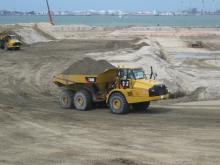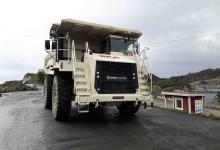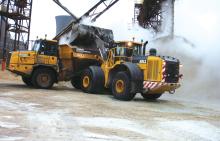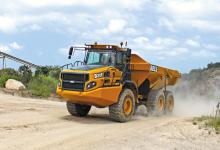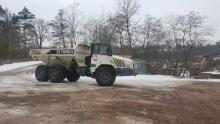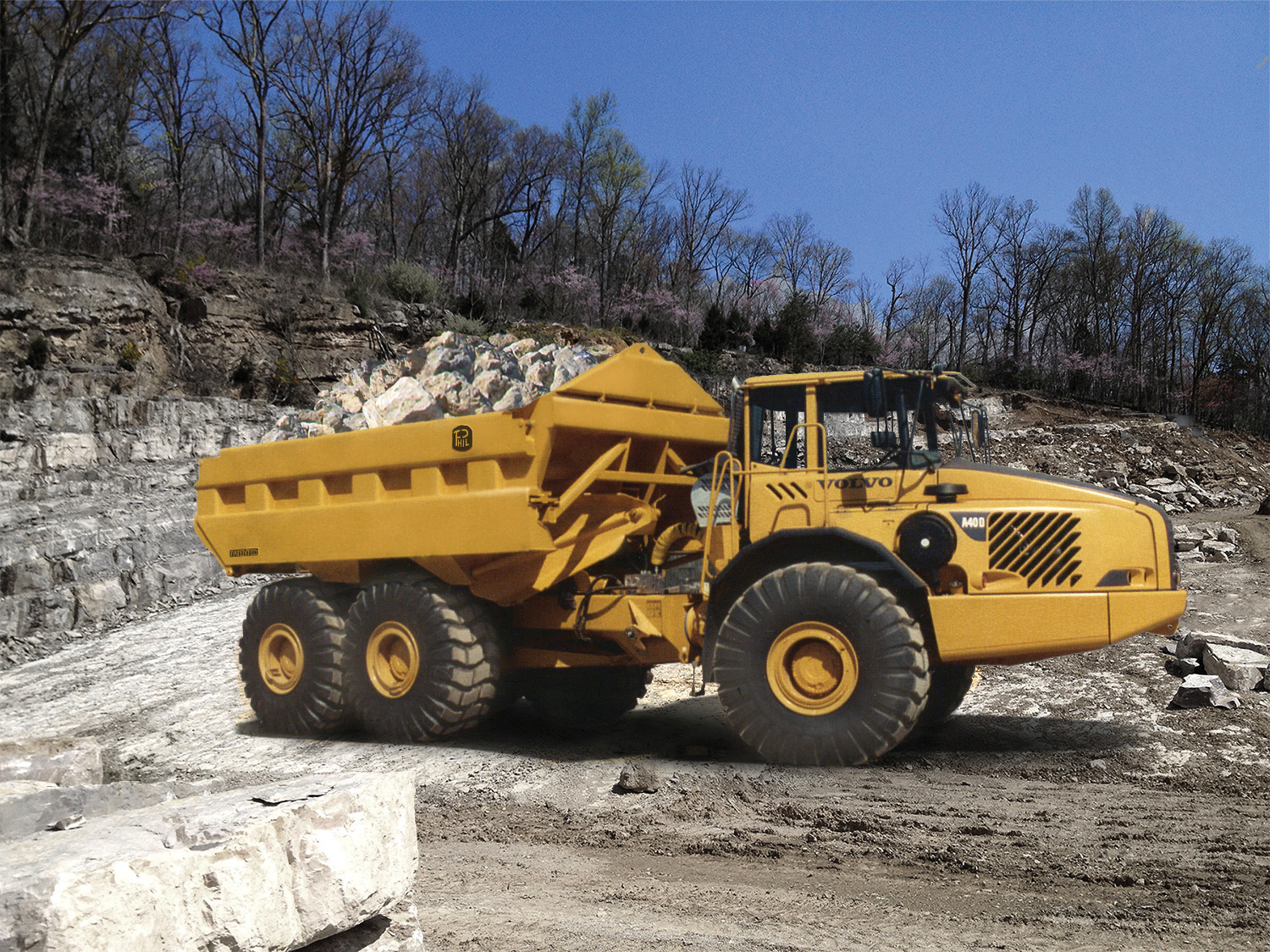
When it comes to hauling material in a quarry, be that uncrushed stone, crushed material or overburden, quarry operators don’t have that many choices.
Smaller sites or those with tough weather and ground conditions will tend towards articulated dump trucks (ADT), while those working with higher payloads, longer hauls and well maintained haul roads will prefer a rigid dump truck (RDT) fleet, writes Dan Gilkes.
The third option of course is to crush the material in-pit with mobile crushers and use conveyors to transfer primary and secondary crushed material around the quarry. All three are well established working methods and they can be combined where necessary to use the best elements of each method for maximum production output.
As with all types of mobile plant at present, dump truck revisions are largely being driven by exhaust emissions legislation. European Stage IIIB and US Tier 4 Interim emissions legislation will soon give way to Stage IV and Tier 4 Final, with almost all manufacturers being forced to adopt some combination of exhaust gas recirculation (EGR); Selective catalytic reduction (SCR); diesel particulate filters (DPF) and diesel oxidation catalysts (DOC).
Increasingly this will be accompanied by additional electronic and computer control, though this is not necessarily a bad thing, as it often comes with improvements in fuel consumption and the possibility of telematic monitoring and diagnostics.
Traditionally the break point between ADTs and RDTs has been at around 45tonnes payload, with the articulated trucks happy to haul below that point, and higher payload almost always demanding the improved haul roads that come with rigid trucks.
The one manufacturer to buck this trend has always been South African company
At present the B60 is only billed as a concept, but Bell has already pushed the boundaries of what is possible, so don’t be surprised to see a production version in the future. The truck uses the same front end as the B50D, but unlike the traditional ADT the 60tonner uses a single rear axle with twin tyres, like a rigid.
The back axle is a 70tonne capacity unit from Kessler in Germany, and to achieve the 60tonne capacity the truck uses a much wider body, shaped like a conventional rigid truck.
“The rear chassis and suspension are distinctly different from an ADT concept,” says chief engineer Wynand van der Wall.
“A cradle supports the rear axle with struts being used to create active shock absorption for a controlled ride.”
The B50D front end has been tweaked slightly, with power from the V8 Mercedes engine boosted from 380kW in the B50D to 420kW. The engineers have also gone with an
“By combining the ADT concept as we know it with a single rear axle, we’ve come up with a unique configuration,” says van der Walt.
“It’s a 4x4 with full articulation steering and oscillation joint and that gives us the ability to keep all four wheels on the ground and fully utilise the traction that’s available. This gives the B60 more off-road capability than any conventional rigid truck.
“A contractor could use this truck on less well maintained roads, when starting a new mine. After establishment, the capacity and performance of the truck would then allow it to be placed directly into a production cycle.”
Bell plans to build additional prototypes to test on customer sites over the next year. This is not the company’s only news, however, as Bell has also added a B50D Ejector to its line-up. Until now the company’s biggest ejector body was fitted to the 40tonne truck, but success with this smaller model has led to development of the 50tonner.
The B50D Ejector has a heaped capacity of 28.3m3 and a rated payload of 43tonnes, compared to the 22m3 and 35tonnes of the B40D Ejector.
“This effectively means that customers will be able to move more material at a lower cost per tonne, while still enjoying the benefits associated with an Ejector body,” says Andrew Staniland, general manager of Bell’s Application Division.
Built in-house, the ejector body can be specified on a new truck, or retro-fitted to older B50D models.
The bodies will be available for the full range of Volvo trucks from the A25F to the A40F, including FS full suspension variants. PHIL’s ejector bodies are said to provide similar volumetric capacities as the regular Volvo tip bodies, though high-volume designs are also available for lighter materials such as landfill and refuse.
The 725C uses Cat’s C9.3 ACERT engine, delivering 234kW, while the larger models are powered by the C13 ACERT motor, with 274kW. Both of these engines can be supplied in Tier 2/Stage II, Tier 3/Stage IIIA or Tier 4 Final/Stage IV emissions configurations, to suit markets around the world. The Tier 4 models use a DPF and SCR with exhaust after-treatment to meet the emissions legislation.
Compared to the B Series models the 725C has 4% more power and a 20% boost in torque, while the 30tonners benefit from a 16% power increase and a hefty 30% improvement in torque output.
The six-speed Cat transmission in the trucks now comes with Advanced Productivity Electronic Control Strategy (APECS), which is said to improve acceleration, increase rimpull, maintain torque converter lock-up and modify gear shift points to match operating conditions. The system is also said to reduce retarding forces for shallower descents in lower gears, all of which lead to improved fuel consumption and reduced cycle times.
For steeper downhill grades, the 730C models get a new engine brake that is said to produce 60% more retarding force than on previous trucks. The smaller 725C uses a hydraulic retarder with four operating modes.
The C Series machines can be ordered with Cat’s Product Link telematic system for improved fleet management, providing remote monitoring and diagnostics through the web-based VisionLink system.
This reliance on remote monitoring is becoming increasingly popular, allowing fleet managers to check operating hours, fuel consumption and other operating data, to allow timely preventative maintenance and maximise production.
Terex is also working on improvements to its rigid truck range, with the TR60 the first to show these upgrades. The company is updating the popular quarry truck with a move to
The TR60 uses a modulating rear brake retarder, which in combination with the engine brake and the transmission retarder provides the truck with three retarding systems to regulate downhill hauling speeds. The RDT also comes with an improved cab interior and upgraded electrical systems, in line with the company’s ADT range. The new dash provides additional information for operators, allowing them to better match the truck’s performance to the job site’s requirements.
Doosan is also offering a limited maximum speed option for customers who want to limit haul speeds in quarries. This not only improves safety, but can also cut fuel consumption.
With that in mind the company has developed an Economy mode for the two trucks, which when engaged automatically controls the engine’s rated speed. This is said to be useful on longer hauls, as the electronically controlled engine and transmission can reduce engine speed to provide optimal power and torque once hauling, improving fuel consumption.
As a more recent entrant to the ADT market,
The truck is powered by Liebherr’s own 16.2litre Stage IIIB/Tier 4 Interim V8 engine developing 350kW of power and a substantial 2,500Nm of torque. This drives through an eight-speed transmission, offering a 57km/hour maximum speed.
There have been some new entrants to the rigid dump truck market this year too, most notably Chinese company
At present most of Sany’s truck sales are to Chinese customers. However, the company has plans to boost sales in 2014 and over the next two to three years it hopes to export up to 50% of truck production. Current export markets for its trucks include Chile, South Africa, Vietnam and Zimbabwe.
Sany claims that its trucks are 10-15% less expensive to purchase and offer fuel savings of 5-8% over more established rivals. Larger trucks are planned, with 180tonne and 300tonne models already on the drawing boards.
Expect to see Sany’s first ADT next year too, with power provided by a Mercedes diesel engine and a driveline similar to many established ADT manufacturers.
As mentioned, some quarries will prefer to use conveyors to transport material, rather than dump trucks. The operational costs of purchasing and maintaining a fleet of trucks are a primary driver in this move, according to conveyor supplier
The German company says that its conveyors offer an economical and environmentally sensitive alternative, with conveyors capable of handling long haul distances, high angles of inclination and tight curve radii.
Direct routing can save time and cost while conveyor systems require fewer personnel to operate and maintain.
Beumer says that depending on the project, belt conveyors can require up to 90% less primary energy than a truck solution.
For those already using belt conveyors systems, American manufacturer
Using Martin’s Trac-mount technology, the modular components are said to be light enough to be removed by hand without the need for cranes.
“The new cradle design only requires one person to change the rollers when the time comes,” says Martin Engineering service technician Doug Brown.
“The biggest problem solved is downtime. In the past when customers have needed to change rollers or frames they had to shut down the conveyor for an extended amount of time. Old style frames can be difficult to remove.”
“We wanted something that was slide in/slide out,” says global product manager Chris Schmelzer. “We can make it as strong as it needs to be without adding excess weight, so workers can remove and replace components without using heavy lifting equipment.”

